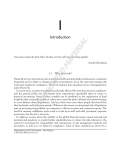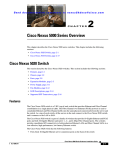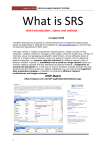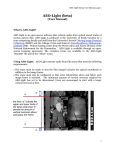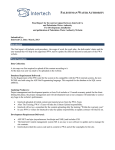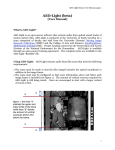Download CONTEXT AWARE CONTENT MARKETING
Transcript
ce Empower your Audien CONTEXT AWARE CONTENT MARKETING FOUR STEPS TO THE FUTURE OF CONTENT, CONTEXT AND MARKETING SUCCESS Introduction Managing, delivering and consuming web content has changed. Yes, again. The universe of options for organizations to create, edit, manage and ultimately publish content to their Web platforms has shifted for the second time in a decade. And, in concert with that change – “content marketing” and the idea of using organic content to improve business results has simultaneously changed the process of digital marketing. Get in touch +1 877 414 4776 [email protected] www.onehippo.com Page 1 of 9 © 2012 - Hippo B.V. e Empower your Audienc Web Content Management Pivots Again In the first part of the 2000’s Web Content Management (WCM) software solutions were focused on one thing — and one thing only; making it easier and more powerful for nontechnical people to move content from their desktop to their web site. Interfaces were critical. Every enterprise web content management provider touted their “easy-to-use” UI and how flexible and intuitive their solution would make the web content management process. And ‘power-user’ features were also key — with the focus on powerful workflows, and approval processes — and the ability to integrate with other enterprise tools. But then, toward the latter part of the decade and lasting up until 2011— the WCMS industry went through another major pivot. The marketing department and the “social web” became the primary business drivers for Web sites — and many of the solutions shifted their focus to solving marketing related challenges. Email campaign management systems, and Web Analytics systems were integrated into web content management, and there became a focus on testing, targeting — and driving more marketing value from the WCMS. Content Marketing Changes The Marketing Department As Web Content Management has moved from being IT driven to marketing driven – “content marketing” and the idea that businesses should become publishers to attract buyers started to fundamentally transform the marketing department. In fact, according to the Content Marketing Institute1 and their 2012 study they conducted in conjunction with Marketing Profs 9 out of 10 organizations are now marketing with content marketing. And, of the 90% that are using Content Marketing, these marketers are employing eight different content marketing tactics (that’s 8 different channels) to achieve their goals. So – when you combine these things together – we see two very distinct things. The CMS industry is pivoting again, just as the entire marketing organization is fundamentally transforming. The explosive growth of content consumption from mobile and social interfaces, the pending expansion of the “internet of things” and consumer expectation of content availability is driving WCMS providers to shift their value proposition. 1 Content Marketing Institute 2012 B2B Content Marketing Benchmarks, Budgets and Trends [Research Report] http://www.contentmarketinginstitute.com/2011/12/2012-b2b-content-marketing-research/CMSWire Page 2 of 9 © 2012 - Hippo B.V. e Empower your Audienc Terms like Web Engagement Management2, and Customer Experience Management are all the buzz among both content marketing practitioners and CMS vendors. In fact, the latest Forrester Wave Report3 for Web Content Management is focused exclusively on vendors providing “Online Customer Experience” using content. Report author Stephen Powers states “functionality to enable publishing to the Web — whether internally or externally — has become commoditized. Yet, now, the WCM market is growing based on customer experience management.” WCM software solutions are increasingly differentiating themselves on a scale of how well their solution can help a customer DELIVER a personalized “web experience” to the client’s consumers through multiple channels such as web, mobile and social. But the idea of WEM (or CXM) itself is a marketing concept — defined by analysts and vendors as a method to create more relevant experiences for consumers using a combination of process and tools. In an article back in May of 2011, CMSWire’s Brice Dunwoodie2 appropriately said: “It’s about managing content, conversations, conversions and relevance in mostly the same place and at almost the same time.” This is the key. The value presented by WEM/CXM is that this process is, at its heart, about managing the audience’s experience in such a way that they ultimately do what the marketer wants them to do. In short — software vendors are going down the same road they went down before. Now, instead of making it “easier to manage Web content” vendors are saying it’s “easy to manage experiences”. Is it any wonder that many have found the whole WEM, CXM trend just another buzz-wordy marketing term? The real transformation of web content management – and how it relates to content marketing – is in empowering our audiences to optimally consume our content when, where and how THEY want it. This gives us the insight to continually get better at the TYPE of content we are delivering, rather than the form it is delivered in. In other words, as we move into the future we should be focused less on how to construct Web experiences for our customers — but rather in opening our content and interfaces so our consumers are ultimately able to create their own. Rather than designing the experience, we should be designing FOR the OPPORTUNITY of experience. And the insight 2 What is Web Engagement Management (WEM)? http://www.cmswire.com/cms/web-engagement/what-is-web-engagement-management-wem-007400.php 3 Forrester Research The Forrester Wave™: Web Content Management For Online Customer Experience, Q3 2011 http://www.forrester.com/rb/Research/wave%26trade%3B_web_content_management_for_online_customer/q/ id/58958/t/2 Page 3 of 9 © 2012 - Hippo B.V. e Empower your Audienc that is derived shouldn’t inform the interface construct — but rather should help authors and editors create BETTER content. That is context-aware content marketing. Figure 1: 4 steps to context aware content The Future Of Context Aware Content Marketing In January of this year, we held a Webinar with the Content Marketing Institute’s Strategist In Residence Robert Rose and we developed what we think is the five year evolution of how context is going to change the world of content marketing. There are four evolutionary steps: • Evolution #1: Becoming Channel Aware This is where most marketers found themselves in 2011 and are perhaps just now starting to really develop strategies for. As evidenced in that study done by CMI, content marketers are – on average – managing upwards of 8 different channels. And organizations now have to manage web content for all these different channels – mobile, social, landing pages, global web sites etc… The first step in Context Aware Content Marketing is simply a realization that it’s not just about dumping content onto one channel any longer. For example, publishing the entirety of our web content onto a mobile site is easier – but it isn’t terribly productive. Marketers must change their content marketing processes to reflect an awareness of context. They must be aware of why audiences are consuming their content through myriad channels. Page 4 of 9 © 2012 - Hippo B.V. e Empower your Audienc A key to this is having the ability to use Meta Data to add contextual attributes to content. A capable WCMS should assit and help users to add meta data attributes – all which can be used to segment, and contextualize the content. For example – even if we don’t use it to segment it today – we must have the ability to assign content to devices, or geo-locations, or personas, so that we might ultimately move to the second evolution and use this data to dynamically present the content contextually. At the moment at most organizations, the management and feedback loop within the Channel Aware state is largely manual. Using Google Analytics reports, content management system reports and manually editing templates, outputs and channels to get insight, make changes and publish to different channels. But thankfully, tools like Hippo CMS, can accommodate an organization to move into the next evolution of context aware content management. • Evolution #2: Becoming Attribute Aware When marketers can become “attribute aware” – the feedback loop and the content iteration process can become much faster – and the contextual awareness can become more pronounced. This is where ‘good’ CMS vendors are positioning themselves these days – but one where Hippo CMS is quite differentiated – having delivered this for a good number of forward-leaning organizations (See Sidebar). In this stage, marketers start to use attributes that can be gleaned from audiences – and use them to optimize content for a contextual situation. For example, the site may automatically detect what type of mobile device an audience member is using (iPhone, Blackberry or Android) and optimize the experience for that interface. This goes beyond just optimizing the design of the interface – but even into length of content. For example where does the “read more” appear on an article. On a mobile device it maybe appears after 250 words; whereas on a desktop interface it might not appear until after 750 words. Additionally, other attributes can be used on combination with one another. For example explicit attributes such as subscriber vs. anonymous user and geographical location and device type might be used all together to deliver a more personal, and contextual experience for the audience member. Page 5 of 9 © 2012 - Hippo B.V. e Empower your Audienc The feedback loop here starts to become slightly more automated. The content repository must be able to adapt to different contexts without the marketers having to worry about manually designing for every variation of that context. And usage data, such as web analytics, conversion rates etc… are also just additional attributes which can and should be used to alter the contextual experience in an automated fashion. For example, the Web interface may display the “most popular” articles. Or, the interface may hide a coupon for a user that’s already converted on that particular offer. And, this contextual relevance brings us to the third evolutionary stage – which employs even more automated feedback loops. • Evolution #3: Becoming Real-Time Aware Marketers will start to be able to optimize content in real-time. Certainly, the early glimpses of this evolution are here today. When we optimize content based on real-time location – or deliver offers based on event-driven actions (e.g. user enters a retail store). But true real-time context awareness begins when we can start changing the content marketing experience even AS the user is interacting with the content. For example, we may want to optimize content as the user interacts with the interface. The system will “watch” the clicks, monitor the speed of connection, track the user’s location – and utilize other real-time behaviors to make subtle, but perhaps important optimization to the content. For example, perhaps the site starts to slim down the images it serves if the speed becomes slow. Or, the content delivery tier watches the behavior of clicks on a cooking site to reveal that the user is a vegetarian. The feedback loop here should be completely automatic – utilizing real-time data availability, plus user behavior to automatically manage and change the interface, the design and even the content. This evolution may, indeed, feed the need to review how marketers look at Web analytics – since we will be delivering very personal experiences. Marketers will need to separate out analytics into persona – or even channel segmented strategies. You can see the very preliminary experiments in Contextual Integration already starting to happen. According to an article on The Next Web, The New York Times decided to charge $15 per month if you tried to subscribe via your Blackberry. But, if you decided to try and subscribe to the newspaper on an iPad – it was $20. This is a very interesting example, as it touches on both the benefit, and the risk to brands delivering content through contextual strategies. In both good and bad ways, real-time contextual integration will begin to have a huge impact on how users consume content – and perceive brands. Then, ultimately – this leads to the next step (perhaps not the last) that we call Contextual Integration. Page 6 of 9 © 2012 - Hippo B.V. e Empower your Audienc • Evolution #4: Contextual Integration Looking at the future – content marketers may actually be looking at a strategy that has gone beyond the interface. Audiences may define their own interfaces – and preferences for consuming content. The idea of a “web site” designed by the organization may feel quaint or even completely unnecessary. In this stage, marketers manage their content as a service – which feeds any interface that requests it. Here, the integration between attributes, real-time data and other third party data services are used interchangeably to deliver a completely contextual experience. So, for example, our content marketing on tourist information may be mashed up with real-time traffic data to provide the best and most contextual experience for a traveler. Or, our content marketing may be served in tiny bits - in context with other services. For example, our video “how-to” series on a particular product – may appear in-line with one of our partner’s “online user’s manual” for a related product. This evolution also starts to address the group of users that “we don’t know”. Even when we’re unable to present content contextually – we should be collecting information about the content usage – and using that to draw further insight. It may be that we start to use external services to better understand the audience that “we don’t know” – especially when our site is new, or when we are launching something brand new. Here a good WCMS tool will help us to integrate information we collect from the content usage, but also from third party systems – and ultimately give us greater insight into our audiences. The feedback loop will be completely, and fundamentally changed by this point – and new metrics will have to be developed to look at content consumption, conversions and other metrics of success. Ultimately, to reach this stage it means that everything from design, search and “look and feel” will be contextually aware – and marketers will be really spending their time focusing on how to segment and create content that is meaningful for as many contexts as possible. This means developing systems that understand how, what and when to deliver content given an astounding number of parameters. In short, it’s not too long from now when we will no longer be managing Web sites, but will rather be managing a contextually aware content platform. Page 7 of 9 © 2012 - Hippo B.V. e Empower your Audienc Beyond Contextual Integration? We pose this as a question. Our ultimate goal as marketers and communicators is, of course, to achieve true personalization; a one-to-one communication that is relevant to the user at the exact place and moment that the user needs it. This is a big goal – and whether or not we can actually create enough content, or technically facilitate enough contexts to thoroughly deliver it – is not the point. If we are to continually improve our brand, share knowledge, or improve the engagement with our customers – anything we can do to adjust context of our content to the context of the user will be a productive exercise. Nothing beats a one-on-one message. Taking The Next Step Certainly these steps are evolutionary – and we may be overestimating how quickly they will arrive. But applying context to content marketing strategy has already started. In order to rise above the noise of today’s content glut – we’ve got to understand and apply who we are talking to – and then what, where, when and (again maybe most importantly) why they want our content through whatever channel we are targeting. Gartner has been releasing research4 and thought leadership about Context Aware Computing for a couple of years now. In fact, they estimate that “by 2012, the typical Global 2000 company will be managing between two and 10 business relationships with context providers, and that by 2015, context will be as influential in mobile consumer services and relationships as search engines are to the Web.” Figure 2: Empower your audience This goes well beyond “managing Web experiences” and traditional “personalization” — and digs deep into how we will enable clients to open their repositories so that things like location, environmental data, history, social attributes, online behavior and other information can be utilized to deliver a more relevant contextual experience in real time. 4 Gartner Research Gartner Says Context-Aware Computing Will Provide Significant Competitive Advantage http://www.gartner.com/it/page.jsp?id=1190313 Page 8 of 9 © 2012 - Hippo B.V. e Empower your Audienc Interestingly most WCMS vendors in the market today are STILL only worried about how to publish pages of content for “web experiences” for the audience user. There is a growing need to not only deliver content through an open and standard set of API’s – but also to provide contextually relevant ways to manage this content as well. This is true context aware content marketing - treating your content as a business platform – and architecting it in such a way that it can be managed, and delivered in extraordinarily flexible ways. At Hippo, we are constantly focused on not only how to create better experiences for audiences; we think that Context Aware Content Management will be the primary way for organizations to deliver the future of content marketing. We know that customers now expect to be able to engage with a company at EVERY stage in their buying process. And, by making it easier and more contextually relevant on both sides – a WCMS can facilitate the conversation and empower the audience. Page 9 of 9 © 2012 - Hippo B.V.














